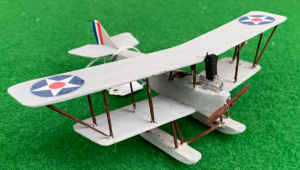Sikorsky S-16
Igor Sikorsky was an early Russian aviation pioneer before WW1. Before and during the war he designed and built a number of aircraft for the Imperial Russia Airforce. One of the early successes was the Russian S-22 Ilya Muromets four-engine biplane heavy bomber. Later Sikorsky designer light weight fighters aircraft to provide protection to heavy bomber fleets. The Sikorsky s-16 was one of these.
The Sikorsky S-16 was a Russian equi-span single-bay two-seat biplane designed by Sikorsky in 1914-15. Conceived in response to demand for an escort fighter for the Ilya Muromets bombers, it was noteworthy in that it was one of the first aircraft to possess synchronisation gear for its 7.7 mm machine gun. The first S-16 was completed on 6 February 1915 with an 80 hp engine instead of the intended 100 hp because of supply problems. On 17 December 1915, the Russian government placed an order for 18 aircraft, these being delivered in early 1916.
Although highly maneuverable, the S-16 possessed a comparatively poor performance due to insufficient power. A further small batch were completed in 1917, with the aircraft being used during the Russian Revolution and staying in service until 1923.


SIKORSKY S-16 INFORMATION
Introduction: January 1916
Primary users: Imperial Russian Air Service
Number Built: about 30
Length: 6.20m
Wingspan: 8.4 m
Engine: 1 × 100 hp Le Rhone/80 hp Gnome air-cooled rotary engine
Maximum Speed: 120 km/h




